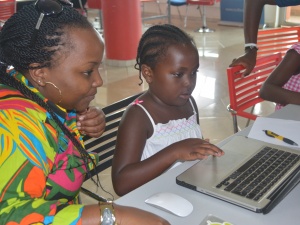You are here
Add new comment
Teaching the Kids How to Think: Journey So Far
Submitted by solomonopio on 7 May 2014 - 7:34am
Together with my team, we have just taken our 1st Kid's Computer Programing class through 2 of 8 sessions of Creative Computing using Scratch.
While the kids seem to be the biggest beneficiaries of this program, it is also a learning experience for my team and I to develop and iterate a working curriculum of Programming for our Kids here in Uganda. I am learning fast that it is really the big ideas of programming- problem solving, thinking mathematically and using logic and reasoning that kids seem to really engage with.
More and more, I see that it is the practical application of those ideas and the creative thinking required to solve authentic problems that forms the basis of a truly engaging learning experience. With each passing session, the students have come back with more than the homework done, much more eager to share their findings and hungrier than before to learn and do more.
Two things I find very fascinating with my class,
- The concentration span- I have been told that kids lose concentration after 30 minutes but I have not witnessed this in my class. I have never been with students so focused and with heightened concentration from start to finish-2 Hours. This makes the teaching experience fun and really enjoyable
- The Eagerness to take on new Challenges. My homework is not the easiest but these kids so a fire and passion for it like I have never seen. They are not afraid one bit to face the challenge and can’t wait to begin.
This takes me back to when I was in school, the times a teacher would leave a tough homework assignment and when you looked around class, one would be met with miserable faces. But here are these kids, learning hard things at a much younger age and very eager to take on the world and get a solution to the problems set before them. Makes me realise, that such an experience is what everyone in my class back then missed out on.
However, I believe our Scratch based curriculum has played an essential role here, to allow us take all of the essential programming constructs like sequencing, conditional branching, control structures, data manipulations, etc, and wrap them round a in a very friendly, very easy to use environment that even the youngest students can use to learn and create things.
Also our use of Design-based learning that emphasizes designing (creating things, not just using or interacting with things), personalizing (creating things that are personally meaningful and relevant), collaborating (working with others on creations), and reflecting (reviewing and rethinking one’s creative practices).
I don’t believe that everyone necessarily needs to become a computer programmer, but I am learning that engaging in the creation of computational artifacts prepares young people for more than careers as computer scientists or as programmers. It supports young people’s development as computational thinkers – individuals who can draw on computational concepts, practices, and perspectives in all aspects of their lives, across disciplines and contexts.
As we going on to our third of eight sessions, I am eager to see what the kids have come up with and I will keep sharing with you my learning and findings. The students will be sharing their projects online in the next class so that you too can keep abreast with what we are doing.
You can be a part of this by
- Add your own idea to the comment section below, on what you think we should look into or add
- Let us help build a nation of better thinkers, one child at a time. Sign Up that young man or woman (7-11 yrs) you know to the program, could be your child, brother, sister, niece, nephew etc. Fill In this form if you are interested and we will alert you when the next class will be.


